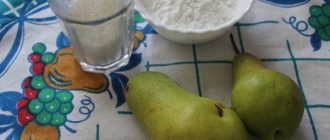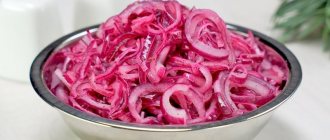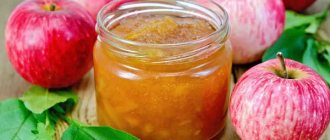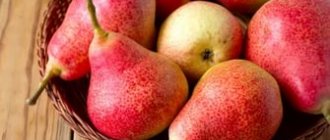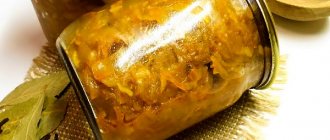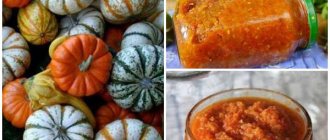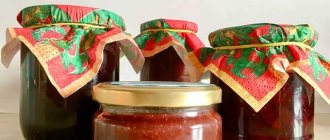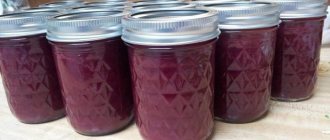Pears - 500 g (peeled)
Granulated sugar - 150 g
Citric acid - 0.25 tsp.
- 124 kcal
Cooking process
To prepare pear puree for the winter, you can take any pears. Depending on their sweetness, the amount of sugar may need to be adjusted slightly. You will also need a small amount of citric acid - for taste - to better preserve the color and the puree itself as a whole.
Prepare the pears (the weight is indicated in peeled form), sugar and citric acid, and let's start preparing pear puree for the winter.
Wash the fruits and cut them into 4 pieces each. Remove the stems and the inside with seeds. Cut the pears into medium-sized pieces.
Place the pear pulp slices in a saucepan.
Add a couple of tablespoons of water, cover the pan and start heating the pears. When the water begins to boil, reduce the heat and simmer the pears for about 10-30 minutes until soft. Depending on the variety, the pears will be ready earlier or later.
Using an immersion blender, puree the soft pears until smooth.
Add sugar and citric acid to the resulting pear puree. Stir. Heat to a boil, boil the pear puree for about 3-4 minutes.
Transfer the puree into a sterile jar (it turns out to be a 0.5 liter jar), close with a sterile lid.
Turn it over and wrap it in something warm. When the jar has cooled to room temperature, store it in the pantry. Pear puree is ready for the winter.
Serve aromatic pear puree on toast, on pancakes, or just on its own.)
Pear puree for the winter: recipes for pear puree
Winter pear preparations are very tasty. Preserves, compotes, jams, pear puree for the winter are equally liked by both children and adults. Delicate, aromatic, with a pleasant light texture, pear puree is a sweet for tea, a filling for baked goods, and the basis for delicious desserts.
Pear puree without sugar is introduced into the diet of children from 6 months, it is used as a sauce for pancakes and pancakes, and is included in the traditional breakfast of oatmeal. For infants, pear puree is a supplier of important components necessary for normal growth and development. The vitamin composition of pear puree for the winter without sugar and its antimicrobial properties promote digestion, strengthen the immune system, and have a beneficial effect on the formation of the child’s intestinal microflora.
Pear puree for the winter: recipes
Even without experience, it’s not difficult to make delicious pear puree for babies for the winter. You need to select juicy, ripe pears, take sugar and a little citric acid. If the pears are sweet, it is better to do without sugar. Just a little bit of citric acid is added to pear puree for the winter to preserve the creamy color of the finished product and balance the sugary-sweet taste.
Wash the fruits, remove the wormholes, tails, receptacles, hard core with seeds. Cut into slices and pieces.
Pour into a saucepan. Add a few tablespoons of water to the pear puree. If the fruit is juicy, you don’t need to add any addition.
Place on low heat and warm up the future pear puree for the baby. The recipe varies, as some consider it more correct to bring the fruit mass to a boil during the first heat treatment.
It is not necessary to adhere to this rule, since after pureeing the fruit will be boiled again. Moreover, there is no need to do this if we want to preserve the vitamin composition of pear puree for the child for the winter, and not prepare a tasty, but not so healthy sweet dessert.
After “warming up,” the soft pears are pureed, that is, turned into a homogeneous mass. The most convenient way to do this is with a blender. If you don’t have a blender, grind pear puree for babies through a sieve for the winter.
A small part of the fresh product can be selected and the boiled, grated pears can be safely introduced into the baby’s complementary foods. To prepare pear puree for the winter, add a little sugar and a pinch of citric acid to the prepared mass. You need to add sugar to pear puree for babies for the winter little by little so as not to over-sweet the puree.
According to the basic recipe, pear puree for the winter should be cooked after boiling and with constant stirring for 4-7 minutes. Then immediately pour into warm sterilized jars and roll up.
Turn upside down, cover with a blanket, and leave to cool for a day. Ready pear puree for the winter for a child is stored in the pantry at room temperature for up to 2 years.
Instead of citric acid, you can “dilute” the sugary taste of pears with sour fruits, such as apples or plums. You will get delicious pear-plum or apple-pear puree for the winter, which children eat with great pleasure. You can even include citrus fruits in the composition, but such a dish is suitable only for adults, as it can provoke allergies in children.
Recipe for pear puree with cinnamon
It is not advisable to prepare pear puree with spices for a baby. But adults will like this version of “baby food”. In addition to cinnamon, which goes well with both pears and apples, the recipe for winter pear puree uses cloves, coriander, and other spicy spices that make the taste of sweet fruits piquant.
- Pears (choose a sweet, juicy variety) – 3 kg.
- Sugar (preferably brown) – 100 g.
- Water – 1 l.
- Cinnamon – 0.5 teaspoon.
First of all, the pears for puree for the winter are washed, peeled, and cut into slices. Place in a bowl.
At the same time, dissolve sugar in water and place the syrup on the stove. Just as when preparing pear puree for babies, prepare containers for packaging: jars are sterilized, can lids are doused with boiling water.
Pour the pear pieces into the boiling syrup in portions. Stirring, wait until the mixture boils and reduce the heat. At the end of cooking, add a little vanilla, cinnamon or add 1-2 buds of cloves to winter pear puree for children.
Cook for another 15 minutes and turn off the heat. All that remains is to puree the cooked fruit. This is done in exactly the same way as in the recipe for pear puree for babies.
The finished product is poured into jars and sealed. It should be stored in a cool, dark place. Apple and pear puree for the winter with cinnamon is prepared according to a similar algorithm. You can also add exotic fruits, such as bananas. In this case, the puree will be very tender; to prevent the vegetables from darkening, you need to pour a few drops of lemon juice into the mixture during cooking.
If possible, you should definitely prepare pear puree for the winter, especially for children. It contains a lot of fat-soluble (A, E, K) and water-soluble vitamins (PP, C, group of B vitamins), folic acid, pectin, plant fiber, tannins, mineral salts, and natural minerals.
In addition, pear puree does not cause an allergic reaction. And the absence of sugar in the composition allows us to classify pear puree for the winter for a child as a dietary food product recommended for consumption by people suffering from obesity and diabetes.
Pear puree for the winter: recipes for pear puree
Winter pear preparations are very tasty. Preserves, compotes, jams, and pear purees are equally liked by children and adults. Delicate, aromatic, with a pleasant light texture, pear puree is a sweet for tea, a filling for baked goods, and the basis for delicious desserts.
How to dry whole green pears for the winter
Rinse the pears well. Dry. Don't cut. Small pears are dried whole. Immerse with acidic water for 5-7 minutes. Water plus citric acid. A pinch of lemon per liter of water. Drain the water. Place the fruits in one row on the trays of an electric dryer. Dry at 70℃. To speed up the drying process, change the trays periodically. Drying time – 15-30 hours. Drying is considered complete when the fruits acquire a soft consistency.
For your attention, there are also new recipes for preparations from the same section:
- “Preserving pears for the winter: 20 step-by-step recipes.”
- “Pickled apples with cinnamon. Unique recipes."
- “Recipe for apple jam. 25 ways to cook deliciously."
Pear puree: the best selection of homemade pear puree recipes
Pears are an ideal fruit for first feeding. They are hypoallergenic and do not cause bloating in children. Adults, just like kids, also love to enjoy delicate pear puree. The selection of recipes presented in this article will please both children and adults.
Choosing pears for puree
For adults, puree can be prepared from absolutely any type of pear. The main thing is that the fruit is as ripe as possible. If there is a lack of natural sweetness, the workpiece can be flavored with granulated sugar.
To feed your baby, you should take the choice of raw materials more seriously. Pear varieties with green skin will not cause allergies. Preference should be given to fruits with juicy and tender pulp. Fully ripened varieties Williams, Komis and Conference have these properties.
In addition to varietal diversity, you should pay attention to the integrity of the skin. It must be undamaged. The fruits should not have dents, signs of rot or wormholes.
Pear puree for first feeding
From baked fruits
Thoroughly washed pears are cut into halves and the seed box is removed. Directly with the skin, the fruit is sent to the oven, heated to 180 degrees. After 15 minutes, the pulp will completely soften and can be scraped out with a dessert spoon.
Instead of an oven, you can bake pears in a microwave oven at maximum power of the device. At the same time, cooking time is reduced by 5 times! The pear will be ready for further processing in just 3 minutes.
The softened pulp is ground through a sieve or punched with a blender until smooth. If the puree turns out to be too thick, then it is diluted with clean boiled water.
From boiled fruits
The pear is thoroughly washed under running water and cleaned. Then each fruit is cut into two parts and freed from seeds. The slices are crushed into small cubes or strips. Place the fruit slices in a saucepan and add a small amount of water. Cook the mixture under a tightly closed lid over medium heat for 10 minutes. Remove the finished pieces from the bowl using a slotted spoon and grind until smooth. The decoction can later be used to prepare a delicious vitamin compote or jelly.
With natural apple juice
The technology for preparing this puree differs from the previous recipe only in that the pear is cooked not in water, but in freshly squeezed apple juice. This puree is offered to the baby at a later stage of complementary feeding.
Pear puree for the winter in jars
Natural puree for the winter
This preparation is prepared only from pears, without additional ingredients in the form of sugar or citric acid.
The fruits are boiled and ground in a blender. The homogeneous mass is put back on the fire and boiled for 10 minutes. In the meantime, the containers are sterilized. The hot mass is placed in containers and covered with boiled lids. The jars are screwed tightly only after sterilizing them for 20 minutes in a water bath.
Puree with sugar and citric acid
- pears – 1 kilogram;
- granulated sugar – 250 grams;
- water – 2 tablespoons;
- citric acid – 1/3 teaspoon.
Pieces of peeled pear are placed in a pan with thick walls. Add water to the cutting. Place the container on the fire and simmer under the lid for 15 minutes.
The boiled mass is crushed until smooth. Sugar and acid are added to it. Before packing into jars, keep the puree on the fire for a little while, 5 minutes will be enough. Tightly rolled jars are covered with a warm blanket and left for a day.
Pear puree with milk
- pears – 1.5 kilograms;
- milk 3.5% fat – 1.5 liters;
- granulated sugar – 1.5 kilograms;
- water – 50 milliliters;
- soda – 5 grams.
Peeled pears are cut into arbitrary pieces, filled with water and set to simmer for 1 hour. After boiling, add the required amount of sugar and continue heating the mass. When the fruit slices have boiled down well, add soda and milk. Over high heat, bring the workpiece to a boil, and then reduce the heat to minimum. Cook the puree for 3 hours.
After the specified time, the mass is crushed using a blender until creamy, heated again on fire for a couple of minutes, and sent to sterile jars. Before sending for long-term storage, the containers are slowly cooled under several layers of terry towels.
The taste of this puree is similar to condensed milk, with a distinct pear aroma.
How to freeze puree
Instead of the usual preservation, you can use freezing. To do this, the preservative citric acid is not added to the puree, and the amount of granulated sugar is reduced or completely eliminated.
It is best to freeze puree in portions. For this you can use small containers with a volume of 150 - 200 grams. Molds for baby puree should first be doused with boiling water. It is better to freeze puree for complementary feeding in silicone molds designed for making ice.
Pear puree: how to make homemade pear puree - the best selection of recipes
Pear puree: the best selection of recipes for homemade pear puree Pears are an ideal fruit for first feeding. They are hypoallergenic and do not cause bloating in children. Adults, along with
Step-by-step preparation
- Pour 3 liters of milk into a saucepan. Bring the milk to a boil. Remove from heat.
- Wash, peel and core 3 kg of ripe pears. Cut the pears into small pieces of arbitrary shape; in the recipe, the pears are cut into thin slices.
- Place the thinly sliced peeled pears into a large saucepan. For cooking, it is better to take a saucepan made of stainless steel.
- Add 1 teaspoon of baking soda and 2 kg of granulated sugar to the pan with pears, stir. Soda is added to quench the acid present in the pears. If you do not add soda, the milk may curdle during further preparation.
- Place the pan with the pears over low heat and cook, stirring, until the pieces are tender, about 30-60 minutes. The exact cooking time depends on the type of pear.
- Place a large saucepan with milk on the fire, pour 1 kg of sugar into the milk, stir until the granulated sugar dissolves.
- Using a blender, puree the boiled pear pieces into a smooth puree.
- Combine sweet milk and pear puree together in a large saucepan. Cook the mixture over low heat for 3-4 hours, stirring the mixture from time to time to prevent it from sticking to the bottom of the pan. During cooking, the mixture should boil down to about 2/3 of its original volume and acquire a caramel color.
- Pour the finished condensed milk into pre-sterilized jars (5-6 half-liter jars), roll up with sterile lids. The result was boiled condensed milk with the taste of pears.
This interesting delicacy can be served with pancakes, pancakes, baked goods filled with condensed pear milk, or simply eaten as a snack with tea. If desired, the amount of sugar in the dish can be adjusted by reducing the mass of the sweet ingredient to suit your taste.
Pear puree for the winter - recipe
Puree is a good alternative to jams and jams, which thrifty housewives prepare for the winter. It can be used as a filling for pies, cakes, pies and donuts. It goes well with butter creams and ice cream. The puree can also be eaten simply as a dessert.
It is especially good to prepare puree for the winter if you have a small child. Pears differ from other fruits and berries in that they do not provoke allergies in a child.
Beneficial features
Many mothers worry that when feeding fruit purees their baby will have excessive colic and bloating. But pediatricians have many arguments in favor of pears:
- Pear is very well absorbed by the child’s body;
- The fiber this fruit contains serves as a wonderful preventative against constipation;
- You can introduce an apple into your child’s diet immediately after introducing it;
- The essential oils contained in this fruit also improve immunity;
- Due to the fact that the pear contains more fructose than glucose, the pancreas will not receive unnecessary stress;
- The composition of the pear is hypoallergenic;
- It does not cause flatulence or fermentation in the intestines of infants;
- Normalizes metabolism in the baby's body.
Useful material
which this fruit contains:
Pear puree for the winter - recipe
In this recipe, pear puree for the winter is prepared without the use of sugar.
. You will need:
- Citric acid - 0.5 teaspoon (can be replaced with lemon juice - 2 tablespoons);
- Ripe pears - 1 kg.
Step-by-step preparation
puree according to this recipe:
- Prepare the fruits: wash them well, cut them, remove the seeds and core;
- Place the pear slices into the multicooker bowl, set the “Stew” mode and cook until they become soft;
- When the pears have softened, place them in a blender and puree until smooth;
- Bring the pear mass to a boil again, adding lemon juice or acid to it;
- While the puree is boiling, prepare the jars. Wash them well with detergent or soda solution, then rinse well with running warm water and sterilize. Place the lids also for sterilization or pour boiling water over them;
- Place the hot preparation into jars and roll them up. Turn over and place under a warm blanket to cool. Then put it in a cool, dark place.
Recipe for making pear puree “Family Joy” for the winter
There are two options for preparing pear puree according to this recipe.
For this recipe you will need the following ingredients:
- Purified water - 1 liter;
- Ripe pear - 3 kg;
- Cinnamon - 0.5 teaspoons;
- Sugar - 100 g;
- Cardamom, cloves, star anise (optional).
Preparation for the winter consists of the following steps:
“Fruit tenderness” - apple and pear puree for the winter
This apple and pear puree for the winter can be prepared without the use of citric acid. In this recipe, the preservative is an apple, which already contains acid.
Products needed for this puree recipe:
- Sour apples - 15 pieces;
- Medium-sized soft pears - 15 pieces;
- Cloves, cinnamon - at the request of the hostess;
- Water - 0.75 cups;
- Sugar - 5-6 tablespoons.
To prepare puree according to this recipe, you will need to go through the following steps:
- Prepare the pears: wash them well, remove the seeds, cut into small slices;
- Prepare the apples: Rinse them well, remove the core and cut into small cubes;
- Pour all the fruits into the multicooker bowl, add water, sugar and cover with a lid. Set the “Baking” or “Stewing” mode for approximately 40 – 60 minutes. Cook until the signal sounds about the end of the process;
- After the signal has sounded, open the lid and wait until the mass of pears and apples has cooled completely;
- Grind the cooled mass in a blender until smooth. Bring the puree back to a boil;
- Place the prepared mass of pears and apples into prepared jars and roll them up.
Recipe: “Children’s” puree from pears and apples
Nowadays, there are many different purees and cereals for children's first complementary foods. It’s just their shelf life that makes you think about the benefits of such a product.
. Most likely, they will contain preservatives, which can serve as a source of allergies for your baby. For any mother, the health of her baby comes first, so below is a recipe for making your own puree from pears and apples.
To prepare you will need (for one serving):
- Ripe and soft pears - 4 pieces;
- Ripe sour apples - 4 pieces;
- Filtered water - 1/3 of a glass;
- Citric acid (if you are going to prepare puree for the winter) - 0.25 teaspoon. It can be replaced with 1 teaspoon of lemon juice.
Cooking method
The puree recipe includes the following:
Recipes for preparing pear puree and apples for the winter
Useful properties of pear; recipes for pear puree for the winter; “family joy” - two preparation options, baby puree from pears and apples.
The primary task of every parent is to raise a healthy and strong baby. And food products become the first helpers in this difficult task. In order for the child to begin receiving useful substances, vitamins and microelements, purees - vegetable and fruit - are introduced into his diet.
Today we will talk about one of the huge variety of purees - pear, and we will figure out at what age you can give your child a pear, how to prepare it correctly and in what quantity to feed the baby.
Classic recipe for condensed milk from pears
Ingredients
- Pears - 500 g (already peeled)
- Milk - 300 ml (fattier, you can even take whole village milk or cream)
- Granulated sugar - 300 g
- Soda - 1 pinch
The taste of this preparation is simultaneously reminiscent of “Toffee” made from boiled condensed milk and pear jam. The only drawback of this puree is that in order to get the caramel taste and the right thickness, you need to boil the pears for quite a long time. You can speed up the preparation by replacing some of the regular liquid milk with dry milk.
Preparation
By the way! If you found this recipe out of season and really want to try it, but you only have frozen pears, that’s okay. They are also suitable for condensed milk.
- Peel the pears, first removing the core and then the skin.
- Mix the pieces with sugar. Leave the pan for 10 minutes, allowing the pears to release their juices.
- Add soda. It will immediately produce abundant foam.
- Now pour in the milk. When everything boils, the jam will immediately foam and try to escape - even in a small amount the milk will behave as usual.
Carefully! From now on, the puree should only be cooked over low heat and under supervision. It is better not to cover the pan with a lid. Remove the foam.
- After this, simmer this caramel-smelling mass for 2 to 4 hours, over low heat (preferably on a divider), without a lid. But if you don’t have time, you can finish cooking after 30-40 minutes. The condensed milk will smell like caramel, but will still be runny. This is not suitable as a filling for pies, but as a topping for desserts and ice cream it’s fine.
Interestingly, pear jam, once golden, can take on an interesting purple hue before turning caramel brown.
- When the jam thickens, you need to puree it with a blender.
- After this, return the pan to the stove for another couple of minutes (the thickness is correct if the puree does not boil, but “hooks” or “spits”). Then roll it into a jar and, turning it over and covering it, wait until it cools.
When can you introduce pear puree into your baby's complementary foods?
Inventory and kitchen appliances
To prepare a treat for your baby, you do not need any special equipment. All the necessary equipment can be found in any kitchen. A saucepan and a blender or meat grinder will be enough. Of course, you can’t do without such familiar kitchen tools as a knife. If it is not possible to use a blender or any other electrical appliance, we suggest adopting a method that uses an ordinary fork and a sieve.
You can also cook the fruit of the pear tree using a double boiler. After this treatment, the fruit will retain almost all its vitamins, unlike cooking. Another option is to prepare pear puree using a slow cooker. Yes, yes, this unit will also cope with the task perfectly.
As you can see, in order to please your child with a tasty and, importantly, healthy home-cooked dish, you don’t need anything supernatural - just a pear, a blender or a meat grinder, a little free time and, of course, the desire to accustom your baby to food rich in vitamins and beneficial microelements .
Ingredients
You don’t even need a dozen ingredients during cooking - the delicacy is simple, and there are very few ingredients in it. This is another beauty of pear puree. After all, often, wanting to cook something healthy, nutritious and at the same time tasty for a child, women come across recipes for dishes with an incredible number of ingredients! Often this is the reason that the baby eats what the mother is used to cooking, without spending her energy and finances on purchasing products and their further processing.
When preparing this dish, we need nothing at all: the pear itself, as the main ingredient, as well as water, a couple of drops of lemon juice and a little honey.
Step by step recipe
So, when everything necessary for the cooking process has been found, you can start cooking. By the way, the recipe is quite simple, so any parent can handle it. Even those who have never tried their hand at cooking before.
However, both he and a more experienced cook need to learn a few subtleties so that the puree turns out really tasty, and the baby is satisfied with this innovation in his diet.
The first thing we need to do is thoroughly wash the selected pear. Peel it, since it is too hard and even after pureeing it may seem too rough to the baby for his fragile gastrointestinal tract. In addition, the skin is by no means the most useful part of the fruit, since it has to interact with the environment.
Important!
It is not advisable to add honey to the first pear puree.
The fruit itself is sweet, especially in comparison with the vegetables that the baby has already tried. To keep your child healthy, nutritionists strongly recommend not adding sweeteners like honey to the diet of very young children. The later they learn the taste of sweets, the better it will be for them. You will also have to get rid of the hard center along with the seeds. Yes, we all know that in the fruit closest to the pear, the apple, it is this part that is most saturated with beneficial microelements, but the baby will not get any better from the seeds in the puree. At least until he grew up.
After these manipulations, the fruit is cut into cubes. You are free to choose the size yourself, but experienced housewives know that the finer the product is cut, the faster it will cook. However, we do not recommend making the cubes too small: this leaves the possibility that a couple of cubes will not turn into the state we need, which means the puree will not be homogeneous.
Place the fruit, peeled and cut, into a selected container and fill with water. Important point:
You should not overdo it with water. It will be enough to fill the saucepan so that the liquid covers the pieces of fruit, no more.
After this, of course, the vessel is placed on the stove - the pear needs to be thermally treated, that is, boiled. A small life hack for housewives: initially you need to let the water boil, and only after that you can lower the cubes into it.
Important!
This cooking method is the fastest.
There are two more: the pear can be baked in the oven or steamed. After such heat treatments, many times more microelements and vitamins remain in the fruit. In addition, the taste of the puree will differ depending on which method of preparing the pear you preferred. It is important to ensure that the product is not overcooked, because in this case it will lose the lion’s share of all useful elements and vitamins. For us, it is important that the pear retains maximum benefits. Therefore, during cooking, check the condition of the fruit by piercing it with a fork.
As a rule, this process takes no more than fifteen minutes. As soon as it becomes soft, remove the container from the stove and take out the boiled cubes. Then pour them into a blender container to puree them. If you don't have a blender, use a meat grinder. If this device is not available to you, use an ordinary fork. To avoid lumps, you can rub the mashed pear with a fork through a strainer.
It is recommended to add a little of the liquid in which your pear was boiled or stewed. Thus, the treat will not be too dense for your child’s growing body and there will be no problems with its digestion.
However, you shouldn’t add too much of it - then your dish will be too liquid, more like a sauce.
Cooking isn't everything. There are several more subtleties and features, as well as rules that we will be happy to share with you.
The “correct” pear for baby puree is green. Ripe, of course. It’s just that a fruit with this color is one of those that causes allergies in isolated cases. It is simply a godsend for preparing meals for kids.
Did you know?
If you don’t pick the main ingredient from the tree, but buy it at the market or in grocery stores, it’s time to learn how to choose it correctly.
The secret is quite simple: pay attention to the aroma the pear exudes. When it is pleasant, the fruit is fresh and tasty. But the lack of smell or even unpleasant notes are a warning: the fruits were stored incorrectly, which is why their taste suffered. In addition, pay attention to the appearance of the fruit: damage to it is unacceptable. If in the fall you can prepare the delicacy presented in the article from fresh fruits, then in winter or spring it will be quite problematic to get a fresh pear. But this is not a reason to refuse the product! It is perfectly acceptable to use frozen fruit. An important condition is their integrity: it is believed that when cut they are less useful.
However, parents do not always have a dacha or plot where they could personally grow ingredients for children’s dishes. Then shops and markets with a variety of choices come to the rescue.
This is a great alternative, but in this case, when you get home, place the fruits in water. It will be enough for the pear to spend about an hour in water for the unwanted substances to be “washed” out of it.
Important!
The most beneficial for your baby will be pears grown in the area where you live.
The liquid during this processing and during stewing or cooking should under no circumstances come from the tap. Preference is given to filtered water, from bottles or bottles.
It is important not to neglect the banal rules of conduct in the kitchen. Keep dishes clean, as well as all utensils. Wash your hands thoroughly before starting cooking, and remove pets, if any, from the premises for a while. Such little things, at first glance, are incredibly important. Animals, for example, can get hair into their food. And unwashed hands spread harmful bacteria.
As for the shelf life of purees, it is definitely worth feeding your baby freshly prepared. You can store homemade pear puree in the refrigerator, but you will have to eat it yourself. Give the child exclusively fresh food.
Like any other dish, pear puree has its own characteristics and subtleties. However, the recipe itself is quite simple, which allows cooks with any level of training to use it. In addition, cooking does not take much time, which is important for young parents.
Therefore, now that we have figured out how to properly make pear puree for babies, no excuses are accepted. Your little one will be only too happy to diversify her menu with something sweet and at the same time healthy.
Healthy and tasty baby puree made with your own hands is a source of joy and pride for any mother. In addition, it is a source of minerals necessary for the development of the child. Today you will learn proven recipes for fruit and vegetable purees that your baby will certainly love.
Applesauce for the winter
One of the most popular and healthy treats that can be prepared for the winter for babies is applesauce. His recipe is completely simple and does not require great culinary skills. It will be loved not only by children, but also by adults as a filling for pies.
Ingredients
- fresh ripe apples - 3-4 kg;
- brown sugar - 100 g;
- water - up to 1 liter;
- a little lemon juice.
It is better to use local varieties of apples, grown at home, with green skin, as they are less likely to cause allergic reactions.
Step by step recipe
Pear puree with condensed milk "Nezhenki" type
Ingredients
- Pears - 1.5 kg (unpeeled)
- Granulated sugar - 50-70 g
- Condensed milk - 130 g (about 0.3 cans)
- Soda - ¼ tsp.
- Water - 2 tbsp. l. (boiling water)
This puree is so named because it tastes and has a smooth, cloudy texture. To make it as angelic as possible, you need to cut out not only the cores, but also the peel from each pear. However, saving time (especially if you have a blender in your hands), you can leave the peel. Its small pieces will appear in the finished jam, but will not spoil it.
Pumpkin puree for the winter
For babies it is considered one of the most delicious and healthy complementary foods. In addition, it is very bright and attracts children with its appearance, making them want to try this orange miracle.
And the recipe for pumpkin puree for the winter is quite quick and easy to make. It is best to use a slow cooker to preserve the beneficial properties of this wonderful vegetable as much as possible.
Ingredients
- 1 medium-sized ripe pumpkin;
- 1 glass of water.
Salt and sugar do not need to be added; they can be used immediately before serving.
Important!
You can use jars of store-bought puree, mustard or sauces as containers for homemade purees; you just need to thoroughly wash them with baking soda and sterilize them first.
Step by step recipe
- Wash the pumpkin, peel it, remove the inside with seeds and all damaged areas, cut the pulp into small cubes.
- Place the pumpkin in the attachment for steaming vegetables and fruits in a multicooker.
- Pour water into the multicooker bowl and set the “steam” mode for 15 minutes.
- Once ready, mash well or beat with a blender until smooth and place in pre-sterilized containers.
- Place the jars in a saucepan with water, covering them 3/4 of the way up, cover with lids and sterilize for 10 minutes.
- Roll up the jars, turn them over and leave them under a warm blanket until they cool completely.
One of the first vegetable purees that kids try is zucchini puree. It is hypoallergenic, has a mild taste and is very healthy for babies; it is good to use not only in the warm season, but also to prepare for the winter. This is especially important if the period of introducing complementary foods occurs during the cold season.
Ingredients
- 1.5 kg of small thin-skinned young zucchini;
- 0.5-1 glass of water.
Step by step recipe
- Wash, peel, remove the seeds and cut the zucchini into small pieces.
- Place the pieces in a colander, place in boiling water and cook for about 10 minutes.
- Take out a colander, wait until the water drains, mash well or beat with a blender until smooth.
- Cook for another 3-5 minutes, place in pre-sterilized containers, cover with lids and sterilize for 10 minutes.
- Roll up and turn over the jars, leave them under a warm blanket until they cool completely.
Instead of cooking the zucchini in a colander, you can simmer it for 10 minutes in a saucepan with a little water.
Then the puree will be lighter. Carrot puree contains a lot of elements that are beneficial for babies, but, like other brightly colored fruits and vegetables, it can cause an allergic reaction. You should not start introducing complementary foods with this puree, however, this is a very important and necessary product, and below is its recipe for the winter.
Ingredients
- 1.5 kg of fresh ripe root vegetables;
- 1 glass of water.
Step by step recipe
- You should not give your baby raw vegetables and fruits; this is too heavy a product for him and can cause gastrointestinal upset. Wait until the baby is a little older.
- Follow the rules for introducing complementary foods - any new product should be started with half a teaspoon. If an allergic or other negative reaction does not occur, the amount of product can be increased slightly at the next feeding.
- You should not eat any one vegetable or fruit all the time; try to take breaks or alternate.
- The water from which vegetables were boiled can be used to prepare children's soups and purees.
- Older kids can start combining different vegetables and fruits, making multi-component purees, eating them with cereals or meat.
These wonderful baby puree recipes, prepared for the winter from pumpkin, apples and other vegetables and fruits, will definitely come in handy for mothers of infants as complementary foods for their babies.
Did you know?
Studies have shown that certain food dyes widely used in the production of children's food products can cause the development of diarrhea in children.
Most often, these are red and yellow dyes. Do not doubt your abilities, this simple preservation is accessible to everyone. And the prepared purees will diversify your diet and delight your kids with new colors and tastes!
Breasts need the maximum supply of vitamins and minerals for the proper functioning of the growing body. Vegetable puree from zucchini or broccoli is perfectly absorbed by children from 4 months of age. At the age of six months, children begin to be given purees from various fruits. Consultants of the Daughters-Sons online store will offer a huge selection of ready-made fruit purees from the best manufacturers.
Zucchini puree for the winter for babies
The baby is growing and for normal development he needs a supplement to his mother's milk. From three months you can start introducing complementary foods. Zucchini puree is ideal for starting complementary feeding. Zucchini does not cause allergies, stimulates digestion and prevents constipation. This vegetable contains vitamins and minerals necessary for the development and growth of the baby.
Zucchini puree for the winter for babies is easy to prepare. You need to take one small zucchini, wash it and peel it; if there are seeds, remove them. After this, the zucchini is cut into small pieces and placed in a steamer or ladle with water. It cooks quickly - about 5-10 minutes. Then the vegetable needs to be crushed and placed in sterile jars, then the puree and the jars should be boiled.
Nowadays, women spend a lot of time at work, they have absolutely no time left for household chores. The apartment of a modern woman is filled with electronic servants who take on most of the household chores. But no matter what, a woman should remain a woman and at least sometimes do something for her family that is not related to money and work. It is important to leave at least two days a week for the family and devote them to creating home comfort, cooking and socializing. Cooking for your family is a pleasure. Therefore, you should not neglect home cooking. After all, it’s not at all necessary to work in the kitchen alone and then collapse on the bed from fatigue. All family members can be involved in cooking and cleaning the house. Together it is much faster and more fun, and in the evening there will be time for family games, watching TV or just talking.
The appearance of a small child in the house changes the way of life of the whole family. Mom can no longer run to the store and to work when she needs to. You have to devote a lot of time to cooking and caring for the child. Some mothers quickly finish breastfeeding, transfer the baby to artificial feeding, purchase ready-made purees in the store and leave the baby in the care of the grandmother. This happens because working mothers cannot afford to stay at home for one and a half or even three years; they feed the whole family and sometimes earn more than dad.
Pear puree for babies is a multivitamin one-ingredient complementary food that can be prepared at home in a few minutes and included in the diet of a six-month-old child.
If your baby enjoys eating a variety of vegetable purees, then fruit purees are exactly the product with which you can not only diversify the children's menu, but also saturate the body with a whole range of necessary and important vitamins for the full development and growth of your child.
Advantages and useful properties
It is simply necessary to introduce a pear into a child’s diet, since it is rich in mineral and vitamin complexes. The fruit is easy to prepare, and the finished puree is quite tasty. 100 g of fruit contains 57 kcal, and its beneficial properties will become a real vitamin bomb.
The choice of pears is due to their remarkable properties:
- they are absolutely hypoallergenic;
- do not cause fermentation in the body;
- effectively strengthen the immune system;
- contain fiber and pectin, which strengthen the liver;
- the fruit contains folic acid, vitamins B and C, as well as a huge supply of potassium, zinc and magnesium.
The pear has a sweetish taste, which will cause the baby to associate it with breast milk. It goes well with apple, pumpkin, carrots and plums. But mixing it with meat proteins is not recommended.
Important!
In small quantities, pear puree weakens, in large quantities it can cause constipation. Therefore, pediatricians recommend initially giving this complementary food in combination with an apple. You need to start with half a teaspoon per day.
Benefits of pear
There is an opinion that a large amount of dietary fiber in the diet leads to bloating and colic. In fact, fiber has absolutely nothing to do with it, because painful sensations arise due to the stabilization of processes in the baby’s gastrointestinal tract. And after 3 months the problems disappear without a trace, although complementary feeding and the first acquaintance with fruit are still far away.
Pediatricians note a lot of positive aspects when eating pears:
- Fiber is an effective preventative against constipation
- The fruit is completely absorbed by the child’s body
- You can introduce a pear into your child’s diet immediately after an apple.
- Essential oils contained in pear improve immunity
- It contains more fructose than glucose, so the pancreas will not receive additional stress
- The pear is hypoallergenic and does not have a bright color, and its qualitative composition is as similar as possible to vegetables that are already familiar to the baby
- Does not cause fermentation and flatulence in the intestines
- Helps normalize metabolic processes
It remains to add a huge amount of useful vitamins and minerals - and the picture about the value of pears will become complete:
- water-soluble PP and C, as well as the entire series of group B
- fat-soluble E, A and K
- folic acid
- pectins
- tannins
- mineral salts, including iron
Pears retain their beneficial properties even in canned form, if you prepare them for the winter correctly, using any recipe you like.
Pear blanks
To prepare the puree, you need to take fruits of uniform color and structure. Homemade fruits will be much healthier than store-bought ones. Before cooking, pears must be washed with a brush, or better yet, doused with boiling water. Then we clean them. Cut the peeled fruits into small cubes and place in a saucepan or multicooker. The ratio of water to fruit should be 2:1. We do not boil the mass under any circumstances, but only let it simmer for 10-15 minutes. The finished puree, crushed with a blender or meat grinder, should have the consistency of thick sour cream.
Such preparations lend themselves well to freezing and are stored in sterilized jars for up to 7 months. It is better not to freeze fruit cubes separately, as most of the beneficial properties will be lost. Fresh fruits can be introduced into children's menus no earlier than 8 months.
